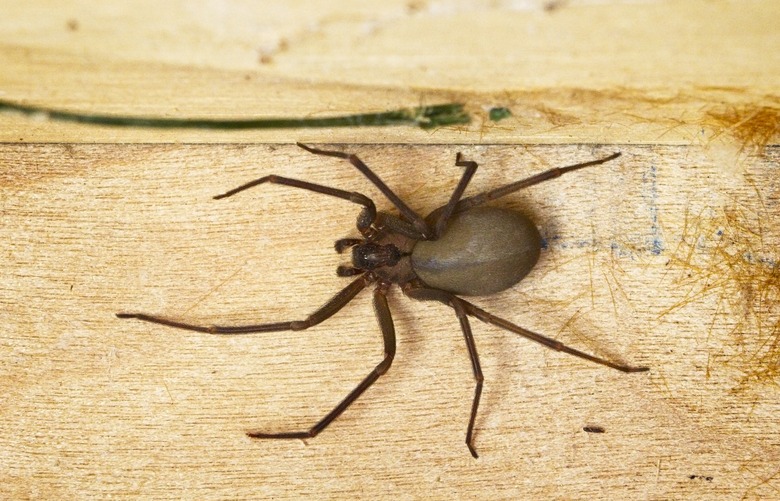What Is The Most Poisonous Spider To Humans?
Nearly all spiders are venomous to one degree or another. Relatively few spiders, however, pose any danger to humans. In the U.S., there are no indigenous spiders whose bites are commonly fatal to adult humans in good health. However, some spider bites can be extremely painful, or even cause permanent injury or disfigurement. Moreover, small children, the elderly, or those who are already ill, are at greater risk.
Significance
Significance
There are only a handful of spiders that are known to have ever killed humans. Of these, only two such spiders are indigenous to the United States. These are the black widow and the brown recluse. However, it is extremely rare for bites of either of these spiders to result in death for human beings. Black widow bites tend to be extremely painful and typically cause muscle pain and severe abdominal cramps. Children are at greater risk, since their smaller body size increases the effectiveness of the venom. Brown recluse bites often result in necrosis (decay) in the area around the bite. While this can leave a nasty scar, only rarely do Brown recluse bites result in death or more severe medical problems. Outside of the U.S. there are two other spiders that tend to cause more severe reactions. The Australian funnel web spider is an aggressive spider that is especially notorious because large numbers of them live in suburban Sydney, Australia. Their bite is similar to that of the black widow spider, but tends to be more severe. Nevertheless, the vast majority of deaths have been in children or in people who were otherwise sick or infirm. The Brazilian wandering spider has an even more ominous reputation. Its has large, powerful fangs that are capable of injecting more venom deeper into its victims. It is believed to be responsible for more deaths than any other spider on earth.
Identification
Identification
The black widow is a small black spider with a large round abdomen. It often, but not always, has a large red splotch on the underside of the abdomen. The brown recluse is a medium sized brown spider with long thin legs and a body about the size of a U.S. penny. The Australian funnel web spider is a large all-black spider with thick legs and large fangs that are visible to the eye. The Brazilian wandering spider is a large brown spider with thick legs. The Brazilian wandering spider is know to be aggressive and will often rear up on its hind legs when threatened, displaying its fangs.
Function
Function
The primary purpose of spider venom is for killing small prey, mostly consisting of insects. As a result, most spiders carry very limited quantities of venom and their fangs are rarely large enough to consistently penetrate through human skin. Therefore even though the venom is in some cases even more potent than the venom of cobras or rattlesnakes, spiders rarely deliver enough venom to seriously endanger a human. In fact, it is quite common for venomous spiders to deliver "dry bites" with no venom at all. This is because it takes them time and energy to create more venom, which they may later need for catching a meal. When spiders bite humans, it is almost always in self-defense.
Geography
Geography
Black widow and brown recluse spiders are found throughout North America, though there are several sub-species of each. The Australian funnel web spider is in many parts of Australia, though the species that lives near Sydney is reported to be particularly aggressive. The Brazilian wandering spider lives throughout eastern South America.
Types
Types
There are two basic types of spider venom. The most common type is a neurotoxin, which works by interfering with the nervous system. This type of poison tends to cause muscle spasms, abdominal cramps, vomiting and respiratory difficulty. The other type of spider toxin, is called necrotoxin. This venom is typically associated with the brown recluse and other closely related species. Necrotic venom kills skin tissue and causes it to decay in a manner similar to diseases such as leprosy. Both types of venom are capable of posing serious danger to humans and can cause permanent injury even if they do not cause death in the quantities typically delivered by a spider..
Cite This Article
MLA
Writer, Contributing. "What Is The Most Poisonous Spider To Humans?" sciencing.com, https://www.sciencing.com/what-poisonous-spider-humans-4586114/. 21 July 2017.
APA
Writer, Contributing. (2017, July 21). What Is The Most Poisonous Spider To Humans?. sciencing.com. Retrieved from https://www.sciencing.com/what-poisonous-spider-humans-4586114/
Chicago
Writer, Contributing. What Is The Most Poisonous Spider To Humans? last modified March 24, 2022. https://www.sciencing.com/what-poisonous-spider-humans-4586114/
